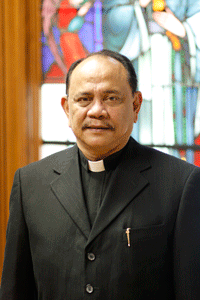The killer typhoon that struck the Philippines in early November has been especially hard on Father Albert Sescon, pastor of St. Thérèse of Lisieux Parish in Cleveland.
Father Sescon has a sister who lived in Tacloban, the city hardest hit by Typhoon Haiyan, known as Typhoon Yolanda in the Philippines. The priest had to wait three days for news that his sister was alive.
“That’s understandable because the communications were cut, there was no electricity, there was no way to go through the roads,” he said in a Nov. 13 interview, “because it was full of debris and trees, poles, and everything, so everybody’s trying to find their own friends and relatives. Some are dead, even, you know.”
The three-day wait was traumatic for Father Sescon.
“It was really an agony and a torture for me, you know, but I surrendered everything to God. Whatever happens, he gave me the strength to accept it,” he said. “Finally, I called my brothers back in the Philippines and other sisters to check, and they have cars, but they couldn’t go through the roads, so they walked like 50 miles. Finally, they found my sister; she was at home. Some were at the hotel, like she was, after the typhoon. She checked her home, and miraculously the whole subdivision was wiped out, but her house was the only one standing.”
Father Sescon had several family members in harm’s way of the storm.
“My sister, her husband, my grand-niece, and one helper in the house,” he said. “They were brought to my brother’s house, which is 300 miles away from Tacloban, but now I’ve heard that there’s been problems on that side of the island, because now the whole island is groping for food—everybody’s really run out of food and gas, you know, so I’ve planned and told them to move to the other island of Cebu. There’s a big city, so they can have a better way of living.”
The priest expected his sister to move to Cebu on Nov. 13.
“I called them last night, and probably today they’re going to Cebu now—if there’s a boat, because now the piers are destroyed, the airports are destroyed, so it’s really hard to travel. The Philippines are an archipelago with close to 700 islands, so if you move from one island to another, you need either to go by boat or by plane.”
Relief efforts for typhoon victims have been slow going, but Father Sescon said that’s understandable.
“It’s not easy to reach the people because, first, the roads are not clear, and it’s an island, so you have to move from one island to another. There’s no communication, and, in fact, one of my nephews went there to bring food, but five cities away he was mobbed by the crowd, so they gave all the food to the crowd because people were getting mad or angry or whatever.”
Getting medication to typhoon victims is another challenge.
“They have no medications in the hospital, especially antibiotics,” Father Sescon said. “Kids are having diarrhea now. I heard from my brothers and sisters, now they’re sick. In fact, one old woman died because there was no medication.”
The devastation in Tacloban almost defies description.
“It was like there was a war when the bomb was dropped and everything was flattened,” Father Sescon said. “Along the way, you find dead bodies. It’s stinking already for two days, and no houses have stood up, and people are walking like they were zombies because they don’t know where to go.
“Money’s not useful anymore because there are no stores—nothing to buy. They want food, so they’re scavenging food from the destroyed stores and everything. My sister’s house is full of mud. The stores are also are full of mud. They were scavenging for food underneath the mud—that’s how terrible it is.”
Father Sescon is glad that U.S. bishops have authorized a special collection for typhoon victims that were taken up either on the weekend of Nov. 16-17 or Nov. 30-Dec. 1.
“The church helping us—that would be a wonderful idea,” he said.

